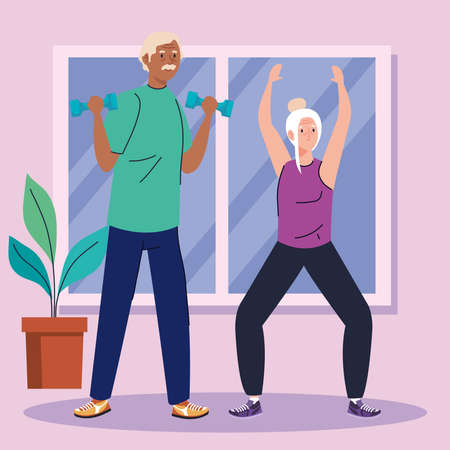Introduction to Power Walking
Power walking has become a popular way for seniors across America to stay active, healthy, and engaged with their communities. Unlike traditional walking, power walking involves moving at a brisk pace with purposeful arm movement, making it both an effective cardiovascular exercise and a low-impact activity. This accessible form of fitness is catching on among older adults because it requires no special equipment or gym membership—just comfortable shoes and a safe path. As more seniors look for enjoyable ways to support their health and independence, power walking stands out as a practical choice that fits seamlessly into daily routines. Its rising popularity reflects not only the growing awareness of the importance of physical activity in aging but also the desire for social connection and outdoor enjoyment.
2. Physical Health Benefits
Power walking offers a range of physical health benefits for seniors, making it a smart and enjoyable way to stay active as the years go by. Not only does this low-impact exercise get your heart pumping, but it also supports your overall wellness in multiple ways. Let’s break down some of the key advantages:
Heart Health
One of the standout benefits of power walking is how it supports cardiovascular health. By keeping your heart rate elevated at a safe level, power walking helps reduce blood pressure, improve circulation, and lower the risk of heart disease. Many doctors in the U.S. recommend regular brisk walks as part of a heart-healthy lifestyle for seniors.
Boosts Immunity
Staying active through power walking can give your immune system a noticeable boost. Moderate-intensity exercise helps increase the production of antibodies and white blood cells, making it easier for your body to fight off illnesses like colds and the flu—something especially important for older adults.
Strengthens Muscles and Bones
As we age, maintaining strong muscles and healthy bones becomes even more crucial. Power walking engages your core, legs, and arms, helping to build muscle strength and improve balance. The repetitive impact also stimulates bone growth, which can help lower the risk of osteoporosis and fractures. Here’s a quick comparison of how power walking stacks up against other activities:
| Activity | Muscle Strengthening | Bone Health Support | Impact Level |
|---|---|---|---|
| Power Walking | Yes (legs, core) | Moderate to High | Low to Moderate |
| Biking | Yes (legs) | Low | Low |
| Aquatic Exercise | Yes (full body) | Low | Very Low |
| Jogging | Yes (legs, core) | High | High |
Weight Management
If you’re looking to maintain or lose weight in a healthy way, power walking is an accessible option. This activity burns calories efficiently without putting too much strain on your joints—a common concern for seniors. Combined with balanced nutrition, regular power walks can help you manage your weight and keep energy levels up.
In summary, power walking delivers a host of physical health benefits for seniors—from protecting your heart to supporting strong bones and muscles. It’s an approachable routine that fits right into American lifestyles while helping you stay vibrant and independent longer.

3. Mental and Emotional Well-Being
Power walking isn’t just about keeping your body fit; it also plays a vital role in nurturing your mind and spirit. For seniors, engaging in regular power walking can provide a noticeable boost to mood by releasing endorphins—nature’s own “feel-good” chemicals. This natural uplift often leads to a brighter outlook on daily life and helps reduce symptoms of depression and anxiety. Just twenty to thirty minutes of brisk walking can make a real difference in how you feel each day.
Beyond emotional benefits, power walking supports cognitive function. Studies show that aerobic activity, like brisk walking, stimulates blood flow to the brain, which may help maintain memory, focus, and overall mental sharpness as we age. Seniors who walk regularly often report feeling more alert and mentally engaged, which is essential for enjoying hobbies, social activities, and meaningful conversations.
Anxiety can sometimes increase with age due to changes in lifestyle or health concerns. Power walking serves as a healthy way to manage stress. The steady rhythm of walking outdoors, especially in green spaces or neighborhood parks, offers a calming routine that soothes nerves and encourages mindfulness.
Finally, power walking can open the door to stronger social connections. Whether joining a local walking club or simply strolling with friends or family, these shared experiences create opportunities for laughter, encouragement, and support. For many seniors, these connections are just as important as the physical exercise itself—promoting both happiness and a sense of belonging.
4. Tips for Getting Started
Jumping into a power walking routine can feel a bit overwhelming at first, but with some simple tips, seniors can safely ease into this energizing activity. Here are practical steps to help you get moving with confidence:
What to Wear
Comfort is key when it comes to power walking. Make sure to choose the right gear that supports your body and keeps you feeling good throughout your walk.
| Item | What to Look For |
|---|---|
| Shoes | Supportive athletic shoes with good arch support and cushioning |
| Clothing | Moisture-wicking, lightweight fabrics; dress in layers for changing weather |
| Socks | Soft, breathable socks to prevent blisters |
Warming Up Properly
Before hitting your stride, spend five to ten minutes warming up. Start by marching in place or taking a gentle stroll. Add some light stretches—focus on your calves, hamstrings, and shoulders—to reduce injury risk and loosen up stiff joints.
Simple Warm-Up Routine:
- Mild marching in place (1-2 minutes)
- Ankle circles (10 each foot)
- Gentle arm swings (10 times)
- Calf stretches against a wall (15 seconds per leg)
Staying Safe While Walking
Your safety comes first. Here are some guidelines to keep every walk worry-free:
- Walk during daylight hours or stick to well-lit areas if walking in the evening.
- If possible, walk with a friend or join a local walking group—it’s safer and more fun!
- Carry a cell phone and let someone know your route.
- Be mindful of uneven sidewalks or slippery surfaces.
Remember:
Pace yourself, listen to your body, and gradually increase your distance over time. With these simple tips, seniors can build a sustainable power walking habit that supports longevity and overall health.
5. Creating a Sustainable Routine
Building a power walking habit that stands the test of time is essential for seniors aiming to stay active and boost longevity.
Strategies for Making Power Walking a Lasting Habit
Consistency is key when it comes to reaping the long-term benefits of power walking. Start by scheduling walks at the same time each day—whether its a brisk morning stroll or an afternoon jaunt after lunch. Setting small, achievable goals, such as walking 15 minutes daily and gradually increasing duration, helps make the routine manageable and less overwhelming. Incorporate variety by choosing different routes or listening to favorite music or podcasts to keep things interesting.
Finding Community Support
The journey becomes much easier—and more enjoyable—when shared with others. Look for local walking groups or senior centers that organize regular walks. Many community centers in the U.S. offer group activities tailored for seniors, providing not only motivation but also opportunities to make new friends. If joining a group isn’t feasible, consider inviting a neighbor or family member along; having a walking buddy increases accountability and turns exercise into social time.
Tracking Progress
Monitoring your achievements can be incredibly motivating. Use a simple notebook or a step-tracking device like a pedometer or smartwatch to log your walks. Celebrate milestones such as reaching a certain number of steps in a week or maintaining your routine for a full month. These small wins reinforce the habit and provide tangible evidence of your commitment to health.
Embracing Flexibility
Life can get busy, but flexibility helps ensure you stick with power walking for the long haul. If you miss a day, don’t get discouraged—just pick up where you left off. Adjust your walking times during inclement weather by heading to an indoor mall or gym track. The goal is to make power walking fit naturally into your lifestyle, so it feels less like a chore and more like an enjoyable part of your day.
Remember: Every Step Counts
No matter how you begin, prioritizing consistency over perfection will help create a sustainable routine that supports health, independence, and longevity for years to come.
6. Community Resources and Programs
Staying motivated and engaged with power walking is easier when you connect with local resources designed specifically for seniors. Across the United States, a wide variety of community programs and walking groups are available to help older adults remain active while enjoying social interaction.
Walking Groups Tailored for Seniors
Many neighborhoods and cities offer senior walking clubs that meet regularly at parks, malls, or recreation centers. These groups often organize gentle routes, take breaks as needed, and foster a supportive atmosphere where everyone encourages each other. Participating in these groups not only boosts physical health but also helps reduce feelings of isolation by building lasting friendships.
Community Centers and Senior Organizations
Local community centers and organizations such as the YMCA or Area Agencies on Aging frequently run fitness classes and power walking programs tailored to seniors’ needs. These programs may include group walks, educational workshops about safe exercise, and special events to keep things fresh and exciting. Many centers also offer transportation assistance for those who need help getting to activities.
Online Resources and Apps
If you prefer flexibility, many online platforms and smartphone apps provide virtual walking challenges, tips, and tracking tools created for older adults. Websites like SilverSneakers or AARP’s community pages list both in-person and virtual events, making it easy to find something that fits your schedule and comfort level.
Tapping into these resources can transform power walking from a solitary activity into a vibrant part of your daily routine. By joining local programs or connecting online, seniors across America can enjoy the full spectrum of benefits that come from staying active together—boosting both health and happiness along the way.
7. Conclusion: Walking Toward Longevity
Power walking is much more than a simple exercise—its a celebration of movement, a daily commitment to wellness, and a key to unlocking a longer, more vibrant life. For seniors, embracing power walking can transform both mind and body, fostering independence, confidence, and joy. Every step you take is an investment in your future health and happiness. Remember, its never too late to start; the journey toward longevity begins with one stride at a time. So lace up those sneakers, invite a friend or loved one, and step out into your neighborhood or local park. Feel the fresh air, notice the world around you, and know that with each walk, youre nurturing not just your body but also your spirit. Power walking isnt just about adding years to your life—its about adding life to your years. Take that first step today and walk confidently toward a healthier, fuller tomorrow.


